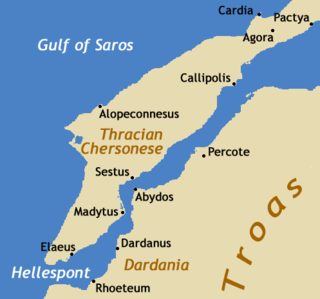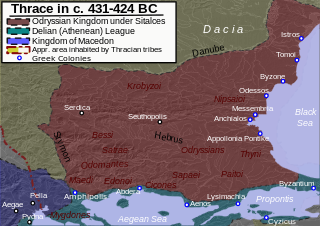Cotys I or Kotys I was a king of the Odrysians in Thrace from 384 BC to his murder in 360 BC. He was known to have been born during the reign of Seuthes I, based on ancient sources and date of birth estimates for Cotys, his daughter who married the Athenian general Iphicrates, and her son Menestheus. According to Harpokration, he reigned for 24 years, which places his accession in 384 BC. Although his origins are actually unknown, An Athenian inscription dated to 330 BC, which honors Reboulas, brother of Cotys and son of king Seuthes. As the ordinal of Seuthes is not mentioned, it was unclear, however, which of the preceding kings named Seuthes is meant by the inscription. While scholars originally believed Seuthes II to be the father of Cotys I, now it is known that Seuthes I was his father, as Seuthes II was only 7 years old at the time of Seuthes I's abdication in 411 BC.

The Thracians were an Indo-European speaking people who inhabited large parts of Southeast Europe in ancient history. Thracians resided mainly in Southeast Europe in modern-day Bulgaria, Romania and northern Greece, but also in north-western Anatolia in Turkey.

Bendis was a Thracian goddess associated with hunting and the moon. Worship of the goddess seems to have been introduced into Attica around 430 BC. Some writers identified Bendis in Attica with the goddess Artemis, but the temple of Bendis at Piraeus which was near the temple of Artemis, clearly display that the two goddesses were distinct. She was a huntress, like Artemis, but was often accompanied by dancing satyrs and maenads, as represented on a fifth-century red-figure stemless cup at Verona.

Religious practices in ancient Greece encompassed a collection of beliefs, rituals, and mythology, in the form of both popular public religion and cult practices. The application of the modern concept of "religion" to ancient cultures has been questioned as anachronistic. The ancient Greeks did not have a word for 'religion' in the modern sense. Likewise, no Greek writer known to us classifies either the gods or the cult practices into separate 'religions'. Instead, for example, Herodotus speaks of the Hellenes as having "common shrines of the gods and sacrifices, and the same kinds of customs."

Attica, or the Attic Peninsula, is a historical region that encompasses the entire Athens metropolitan area, which consists of the city of Athens, the capital of Greece and the core city of the metropolitan area, as well as its surrounding suburban cities and towns. It is a peninsula projecting into the Aegean Sea, bordering on Boeotia to the north and Megaris to the west. The southern tip of the peninsula, known as Laurion, was an important mining region.

Sestos was an ancient city in Thrace. It was located at the Thracian Chersonese peninsula on the European coast of the Hellespont, opposite the ancient city of Abydos, and near the town of Eceabat in Turkey.

Perdiccas II was the king of Macedonia from 454 BC until his death in 413 BC. During the Peloponnesian War, he frequently switched sides between Sparta and Athens.

The Odrysian kingdom was an ancient Thracian state that thrived between the early 5th century BC and the early 3rd / late 1st century BC. Located in present-day Bulgaria, southeastern Romania, northern Greece and European Turkey, it was a tribal amalgam dominated by the Odrysians that was the first large political entity to develop in the eastern Balkans. Before the foundation of Seuthopolis in the late 4th century it had no fixed capital.
Pyanopsia (Πυανόψια) or Pyanepsia (Πυανέψια) was an ancient Athenian festival held in honor of Apollo in Athens on the 7th day of the month Pyanepsion (October/November). Its name literally means "bean-stewing", in reference to one of the sacred offerings given during this time, and is taken from the Greek words πύανος - pyanos "bean" and ἕψειν - hepsein "to boil".
Cersobleptes, was son of Cotys I, king of the Odrysians in Thrace, on whose death in September 360 BC he inherited the throne.

The Thracian religion comprised the mythology, ritual practices and beliefs of the Thracians, a collection of closely related ancient Indo-European peoples who inhabited eastern and southeastern Europe and northwestern Anatolia throughout antiquity and who included the Thracians proper, the Getae, the Dacians, and the Bithynians. The Thracians themselves did not leave an extensive written corpus of their mythology and rituals, but information about their beliefs is nevertheless available through epigraphic and iconographic sources, as well as through ancient Greek writings.

The Adonia was a festival celebrated annually by women in ancient Greece to mourn the death of Adonis, the consort of Aphrodite. It is best attested in classical Athens, though other sources provide evidence for the ritual mourning of Adonis elsewhere in the Greek world, including Hellenistic Alexandria and Argos in the second century AD.

Elaeus, the “Olive City”, was an ancient Greek city located in Thrace, on the Thracian Chersonese. Elaeus was located at the southern end of the Hellespont near the southernmost point of the Thracian Chersonese in modern-day Turkey. According to the geographer Scymnus, Elaeus was founded by settlers from Ionian Teos, while the Pseudo-Scymnus writes that it was a colony of Athens and was founded by Phorbas
The Oschophoria were a set of ancient Greek festival rites held in Athens during the month Pyanepsion (autumn) in honor of Dionysus, the god of the vine. The festival may have had both agricultural and initiatory functions. Amidst much singing of special songs, two young men dressed in women's clothes would bear branches with grape-clusters attached (ὠσχοί) from Dionysus to the sanctuary of Athena Skiras, and a footrace followed in which select ephebes competed. Ancient sources connect the festival and its rituals to the Athenian hero-king Theseus and specifically to his return from his Cretan adventure. According to that myth, the Cretan princess Ariadne, whom Theseus had abandoned on the island of Naxos while voyaging home, was rescued by an admiring Dionysus; thus the Oschophoria may have honored Ariadne as well. A section of the ancient calendar frieze incorporated into the Byzantine Panagia Gorgoepikoos church in Athens, corresponding to the month Pyanopsion, has been identified as an illustration of this festival's procession.
The Synoikia was an ancient Greek festival held in Athens commemorating the political unification of Attica. It was also called the Thesean Synoikismos and the Feast of Union, and celebrated Theseus as founder of Athens and the goddess Athena as the city's patron goddess. The festival was celebrated in the month of Hekatombeion on the 16th. A two-day festival, on the 15th and the 16th was held every second year.

The city of Athens during the classical period of ancient Greece was the major urban centre of the notable polis (city-state) of the same name, located in Attica, Greece, leading the Delian League in the Peloponnesian War against Sparta and the Peloponnesian League. Athenian democracy was established in 508 BC under Cleisthenes following the tyranny of Isagoras. This system remained remarkably stable, and with a few brief interruptions remained in place for 180 years, until 322 BC. The peak of Athenian hegemony was achieved in the 440s to 430s BC, known as the Age of Pericles.

In ancient Greek religion, an orgion was an ecstatic form of worship characteristic of some mystery cults. The orgion is in particular a cult ceremony of Dionysos, celebrated widely in Arcadia, featuring "unrestrained" masked dances by torchlight and animal sacrifice by means of random slashing that evoked the god's own rending and suffering at the hands of the Titans. The orgia that explained the role of the Titans in Dionysos's dismemberment were said to have been composed by Onomacritus. Greek art and literature, as well as some patristic texts, indicate that the orgia involved snake handling.
The festival calendar of Classical Athens involved the staging of many festivals each year. This includes festivals held in honor of Athena, Dionysus, Apollo, Artemis, Demeter, Persephone, Hermes, and Herakles. Other Athenian festivals were based around family, citizenship, sacrifice, and women. There were at least 120 festival days each year.
The Pandia was an ancient state festival attested as having been held annually at Athens as early as the time of Demosthenes. Although little that is known of the Pandia is certain, it was probably a festival for Zeus, and was celebrated in the spring after the City Dionysia in the middle of the month of Elaphebolion.
Pandion was the eponymous hero of the Attic tribe Pandionis, which was created as part of the tribal reforms of Cleisthenes at the end of the sixth century BC. He is usually assumed to be one of the two legendary kings of Athens, Pandion I or Pandion II.











